Electronics News
Archive : 23 July 2015 год
 Previously deployed for military purposes, a new commercial version of the Omnideck from the Swedish company Omnifinity has been installed at the Transport Systems Catapult's (TSC) Innovation Centre in Milton Keynes.
Previously deployed for military purposes, a new commercial version of the Omnideck from the Swedish company Omnifinity has been installed at the Transport Systems Catapult's (TSC) Innovation Centre in Milton Keynes.
Part of the centre's 'Visualisation laboratory' it is the UK's first commercially available omnidirectional treadmill that features a 'virtual reality' rendering of Milton Keynes, built by local firm Virtual Viewing.
The Omnideck is a 360° treadmill that has been hooked up to a VR headset and tracker system, allowing individuals to move around a virtual environment.
The omnidirectional treadmills are able to track an individual's movement and how far they travel and as a result can determine how fast the individual on screen is moving. The system uses a series of 16 motorised triangular sections of rollers with an underlying belt that moves along with the user. According to the company this will guarantee that the user will not walk right off the treadmill and that the system can accurately track movements up to 4.5mph
The TSC says that the technology will enable engineers and designers to test the impact of new transport services and technological innovations without the risks and costs of physical implementation.
"The Omnideck Treadmill and virtual reality equipment we have installed are totally unique in the UK and will allow businesses to experiment, develop and demonstrate new technologies," said Graham Fletcher, Modelling and Visualisation Director at TSC. "One possible use is the testing of driverless cars. We will be able to conduct user trials in a virtual environment and we have already had interest from major manufacturers in testing their vehicles in this way before implementation on UK roads."
Omnifinity was formed by MSE Engineer, a firm known mostly for combat simulation products, and the Omnideck was originally developed to address the market for immersive gaming, specifically using the Oculus Rift, the virtual reality headset.
Author
Neil Tyler
Source: www.newelectronics.co.uk
 Blu Wireless Technology has joined the University of Surrey's 5G Innovation Centre (5GIC) as part of its SME Technology partner programme.
Blu Wireless Technology has joined the University of Surrey's 5G Innovation Centre (5GIC) as part of its SME Technology partner programme.
Due to open in September 2015, the 5GIC is said to be the UK's only research centre dedicated to the next generation of mobile communications. The centre aims to bring together leading academic expertise and key industry partners in a shared vision to develop standards and technology for fifth generation wireless networks.
Professor Rahim Tafazolli, director of 5GIC, said "With Blu Wireless joining the Centre, our collaborative efforts are further strengthened particularly in millimetric band technologies. We look forward to working with them and integrating their equipment and expertise into our new test bed."
Blu Wireless will work with the 5GIC to integrate its 'Lightning' millimetre wave gigabit modems within the 5GIC mobile testbed. Blu Wireless will also assist with general technical collaboration on requirements and technology for advanced baseband modems for the 5G millimeter-wave modem.
Mark Barrett, Blu Wireless cmo, said: "Our technology will enable 5G infrastructure and access applications and will help to drive the research that will underpin the 5G standards of the future."
Author
Tom Austin-Morgan
Source: www.newelectronics.co.uk
 ROHM has announced that it has completed the acquisition of Powervation for approximately $70million. The combination of Powervation's Intelligent Digital Power platform with ROHM's analogue power technology and global market access will enable the company to address a range of market opportunities in digital high density systems and ICs such as processors, memory, FPGAs, and ASICs.
ROHM has announced that it has completed the acquisition of Powervation for approximately $70million. The combination of Powervation's Intelligent Digital Power platform with ROHM's analogue power technology and global market access will enable the company to address a range of market opportunities in digital high density systems and ICs such as processors, memory, FPGAs, and ASICs.
According to market research reports, digital power continues to progressively displace traditional analogue technology in the $11b global power management IC market driven by its performance and energy efficiency advantages.
"The combination of our two companies will enable ROHM to develop industry-leading, integrated digital power solutions to serve a broad range of customers, markets, and applications spanning the entire spectrum from Computing and Communications to Consumer and Industrial," said Jun Iida, head of LSI development and member of the ROHM board of directors.
Powervation will become a fully owned subsidiary of ROHM, which plans to accelerate product development through investment and synergies with ROHM analogue / discrete power technologies and to increase market adoption by leveraging its global customer base and channels.
Mike McAuliffe, ceo of Powervation said: "We have built an innovative Digital Power IC company to date but the combination with ROHM now presents a compelling opportunity for broad market leadership in Digital Power Management solutions."
Pic: Mike McAuliffe, ceo of Powervation
Author
Tom Austin-Morgan
Source: www.newelectronics.co.uk
 More than 4500 Qualcomm employees are set to lose their jobs in the wake of a strategic realignment plan designed to improve the company's financial position.
More than 4500 Qualcomm employees are set to lose their jobs in the wake of a strategic realignment plan designed to improve the company's financial position.
In its third quarter results, Qualcomm saw its revenues decline to $5.8billion, 14% lower than Q3 2014 and $1.1bn less than revenues in Q2 2015.
The strategic realignment plan calls for: 'rightsizing' the cost structure by eliminating approximately $1.4bn in spending; reviewing alternatives to the corporate and financial structure; reaffirming the plan to return significant capital to stockholders; adding directors with complementary skills; further aligning executive compensation with performance; and disciplined investment in areas that further Qualcomm's leadership positions.
"We are making fundamental changes to position Qualcomm for improved execution, financial and operating performance," said Steve Mollenkopf, pictured, Qualcomm's CEO. "Our strategic realignment plan is designed to drive meaningful change in the near term without jeopardising our ability to retain and build upon our technology leadership position and create long-term value for our stockholders."
The plan calls for Qualcomm to review of its corporate structure, including possible business separation alternatives. Currently, the company has two main operations – chip design and IP licensing, with the latter activity more profitable by far. Some analysts have speculated that either branch could be spun off.
Qualcomm says that it will continue to make 'disciplined investment' to maintain technology leadership and to drive growth while delivering attractive returns. These investments will be focused on technologies that scale across opportunities in the smartphone and adjacent markets, including modems and other differentiated technologies. Particular target markets include data centres, small cells and certain IoT verticals.
"Qualcomm has been and will continue to be the industry leader in mobile technologies," Mollenkopf contended. "We have tremendous advantages and IP leadership and are well positioned to capitalise on the significant long-term opportunities before us as mobile computing dramatically expands beyond the smartphone."
Pic: Steve Mollenkopf, Qualcomm's CEO
Author
Graham Pitcher
Source: www.newelectronics.co.uk
 Researchers at the US Department of Energy's Oak Ridge National Laboratory (ORNL) have combined a novel synthesis process with commercial electron-beam lithography techniques to produce arrays of semiconductor junctions in arbitrary patterns within a 1nm-thick semiconductor crystal. This compares to the 10nm-thick crystals currently used in leading edge chips.
Researchers at the US Department of Energy's Oak Ridge National Laboratory (ORNL) have combined a novel synthesis process with commercial electron-beam lithography techniques to produce arrays of semiconductor junctions in arbitrary patterns within a 1nm-thick semiconductor crystal. This compares to the 10nm-thick crystals currently used in leading edge chips.
David Geohegan, co-leader of the study, said: "The development of a scalable, easily implemented process to lithographically pattern and easily form lateral semiconducting heterojunctions within 2D crystals fulfils a critical need for 'building blocks' to enable next-generation ultrathin devices for applications ranging from flexible consumer electronics to solar energy."
The researchers first grew 1nm-thick layers of molybdenum diselenide crystals on substrates and then deposited protective patterns of silicon oxide using standard lithography techniques. They then bombarded the exposed regions of the crystals with a laser-generated beam of sulphur atoms. The researchers say the sulphur atoms replaced the selenium atoms in the crystals to form molybdenum disulphide, which is said to have a nearly identical crystal structure. The two semiconductor crystals formed sharp junctions, the desired building blocks of electronics.
Masoud Mahjouri-Samani, who also co-led the study said: "In the future, it might be possible to produce different patterns on the top and bottom of a sheet. Further complexity could be introduced by layering sheets with different patterns."
Next, the researchers will see if their pulsed laser vaporisation and conversion method will work with atoms other than sulphur and selenium. "We're trying to make more complex systems in a 2D plane because a complete working device needs different semiconductors and metals and insulators," Mahjouri-Samani concluded.
Author
Tom Austin-Morgan
Source: www.newelectronics.co.uk
 ARM's second quarter results show the company grew revenue by 15% in Dollars over the same period in 2014, and by 22% when stated in Sterling. The figures also showed that processor royalty revenues grew by 31% year on year and that 54 licences were signed in Q2, which the company says is a record.
ARM's second quarter results show the company grew revenue by 15% in Dollars over the same period in 2014, and by 22% when stated in Sterling. The figures also showed that processor royalty revenues grew by 31% year on year and that 54 licences were signed in Q2, which the company says is a record.
Pete Hutton, president of ARM's product groups, pictured, said: "The results are good. There's a nice 'uptick' in revenues and royalties and the 54 licences we signed is a record for one quarter. But one interesting point is that five of those licences were signed by large OEMS. That shows that more companies are starting to build their own chips."
According to Hutton, there are now a lot of companies working on next generation products, giving feedback and taking licences. "There were 150million ARMv8 cores shipped in the quarter and take up, which has only just started, is a lot faster than we predicted.
We did a lot of work to get the software in place and the ecosystem established. Now, users are getting to grips with v8 quite easily and are picking up the core faster than we thought."
Hutton said v8 cores are now being applied beyond the obvious areas of smartphones and tablets. "There's progress in enterprise networking and it's the early days in servers. The hardware is in place for servers, it's now the software ecosystem which needs developing, which is what we always thought.
"Servers were an area we pushed into, but we're now seeing pull from end users as they begin to see solutions in place. Now, it's about porting software to the ARM platform."
Meanwhile, another 20 Cortex-M licences were signed in the quarter, including six new customers, taking the total number of M class licenses to 318. The company says Cortex-M now represents 40% of all shipments of its processors.
Eight licences were signed for Cortex-R class processors. These included an additional licence for 'Kite', the first ARMv8-R class processor, which is designed for safety related automotive and industrial applications. "The Kite licence is one of the highlights of the quarter," Hutton concluded.
Pic: Pete Hutton, president of ARM's product groups
Author
Graham Pitcher
Source: www.newelectronics.co.uk
 Imagination Technologies has joined the 5G Innovation Centre (5GIC) at the University of Surrey to collaborate with leading companies in exploring, developing and defining underlying technologies that will power the next-generation 5G mobile communications network.
Imagination Technologies has joined the 5G Innovation Centre (5GIC) at the University of Surrey to collaborate with leading companies in exploring, developing and defining underlying technologies that will power the next-generation 5G mobile communications network.
Imagination says it will invest significant resources into 5GIC over the next five years to help 5GIC develop technologies that will be scalable and deployable by the widest possible semiconductor, electronics goods and service provider community.
Professor Rahim Tafazolli, director of the 5GIC and Institute of Communication Systems, said: "Imagination complements the other members, which will enable us to address not only the operator and device manufacturers but, thanks to Imagination, also the needs of the global semiconductor industry."
The 5GIC is a UK-based research centre dedicated to enabling the next generation of mobile communications. Other members of the 5GIC include major telecom service providers and mobile device manufacturers.
5G will be a flexible infrastructure capable of handling consumers' increasing demands for mobile data and providing ubiquitous connectivity for emerging markets such as the IoT.
Hossein Yassaie, ceo of Imagination, said. "5G will deliver more efficiency, lower power and better robustness – but also connect everything in the world of IoT. We look forward to working with 5GIC and partners around the world to help deliver this important global technology."
Pic: Hossein Yassaie, ceo of Imagination
Author
Tom Austin-Morgan
Source: www.newelectronics.co.uk

